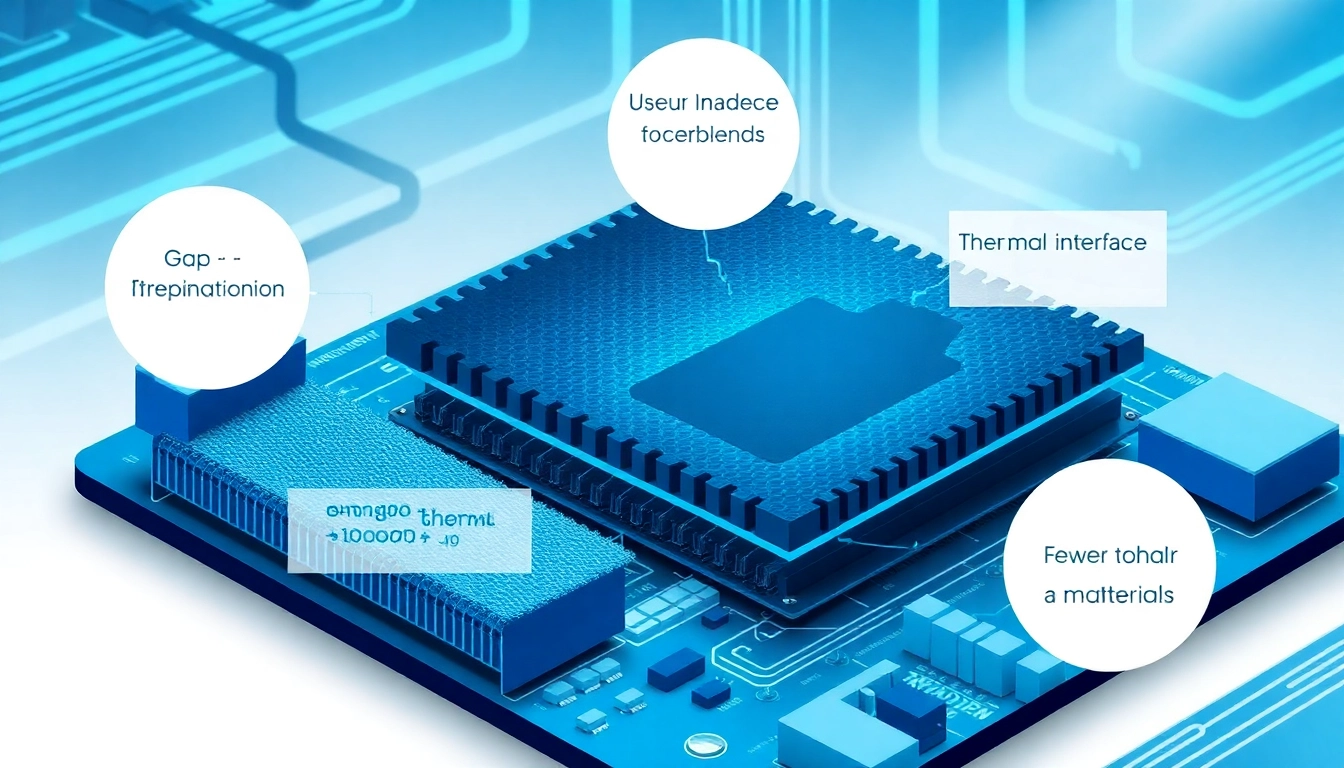Understanding Thermal Management Materials
In today’s fast-paced technological landscape, the efficiency and reliability of electronic devices hinge significantly on effective thermal management. As components continue to shrink in size while increasing in performance capabilities, the need for high-quality thermal management materials has become more critical than ever. These materials are designed to facilitate heat dissipation, prevent overheating, and ultimately enhance device longevity and performance. In this comprehensive article, we will delve into the intricacies of thermal management materials, exploring their types, applications, innovations, and best practices for implementation.
What are Thermal Management Materials?
Thermal management materials encompass a broad range of products engineered to effectively dissipate heat generated by electronic components. By maintaining optimal operating temperatures, thermal management materials help prevent damage caused by overheating, ensuring the reliability of devices. These materials are utilized in various configurations, including thermal interface materials (TIMs), gap fillers, heat sinks, and phase change materials (PCMs), among others.
Importance of Proper Heat Dissipation
The primary objective of thermal management is to ensure that excess heat generated in electronic applications is efficiently transferred away from heat-producing components. Effective heat dissipation is crucial for several reasons:
- Device Reliability: Overheating can lead to premature failure of components, reducing overall device lifespan.
- Performance Optimization: Operating at optimal temperatures enhances the efficiency of devices, allowing them to perform better under load.
- Energy Efficiency: Effective thermal management contributes to lower energy consumption, mitigating heat-induced inefficiencies.
Common Types of Thermal Management Materials
There are several types of thermal management materials, each specifically tailored for various applications. Below are some of the most commonly used materials:
- Thermal Interface Materials (TIMs): These materials facilitate heat transfer between hot components and heat sinks. They improve thermal conductivity and reduce thermal resistance.
- Gap Fillers: Soft materials that conform to the surfaces of components, filling in air gaps to enhance thermal coupling, often used in devices with uneven surfaces.
- Phase Change Materials (PCMs): Materials that absorb and release thermal energy during phase transitions, helping to stabilize temperature fluctuations.
- Thermal Adhesives and Tapes: Used for attaching heat sinks to components, improving thermal transfer while providing mechanical bonding.
Key Applications of Thermal Management Materials
Electronics and Consumer Devices
The electronics sector is the primary market for thermal management materials. Devices such as smartphones, laptops, and tablets generate significant heat during use. Effective thermal management ensures that these devices maintain performance and user safety. For instance, smartphones have increasingly adopted thermal interface materials to ensure that processors and batteries do not overheat during heavy usage, thus prolonging battery life and operational stability.
Automotive and Aerospace Industries
In the automotive sector, thermal management materials are essential for managing heat in engines, batteries, and electronic control units (ECUs). The shift toward electric vehicles (EVs) has further amplified the demand for advanced thermal management solutions, especially concerning battery cooling systems. Similarly, aerospace applications utilize these materials to ensure that intricate electronic systems maintain optimal operating temperatures, contributing to aircraft safety and performance.
LED Lighting and Thermal Applications
As LED technology becomes increasingly prevalent, effective heat management in LED applications is crucial. LEDs generate substantial thermal energy that must be dissipated to enhance brightness and ensure longevity. Thermal management materials, such as gap fillers and thermal interface materials, are commonly used in LED assemblies to maintain optimal thermal conditions and improve overall light output.
Choosing the Right Thermal Management Materials
Factors to Consider for Specific Applications
Selecting the appropriate thermal management material is critical for optimizing performance. Key factors to consider include:
- Thermal Conductivity: The material’s ability to conduct heat. Higher thermal conductivity values are typically desired in high-performance applications.
- Mechanical Properties: The material should exhibit adequate mechanical strength and flexibility to withstand application stresses.
- Operating Temperature Range: Ensure that the material remains effective within the operational temperature range of the application.
- Application Method: Consider whether the material will be applied in the form of a paste, tape, or solid interface, as this affects ease of installation and performance.
Comparative Analysis of Different Materials
When evaluating thermal management materials, it’s critical to compare their performance characteristics. For example, traditional thermal greases exhibit higher thermal conductivity; however, they may require precise application methods. In contrast, thermal pads provide ease of use with good thermal performance but may not reach the same level of conductivity as some greases. Additionally, phase change materials (PCMs) offer unique advantages in applications where temperature stabilization is necessary.
Understanding Material Specifications
Understanding the specifications of thermal management materials is essential for making informed decisions. Key specifications include:
- Thermal Resistance: The measure of a material’s resistance to heat flow, typically expressed in °C/W.
- Thermal Conductivity: The ability of a material to conduct heat, usually measured in W/mK.
- Viscosity: Important for thermal greases and adhesives, as it affects the ease of application.
- Dielectric Strength: Essential in applications where electrical insulation is necessary.
Innovations in Thermal Management Technologies
Advanced Materials for Electronics
Ongoing research and development have led to the advent of innovative thermal management materials tailored for high-performance electronics. New composites that incorporate nanoparticles enhance thermal conductivity while reducing weight. These materials not only perform better but also meet stringent space and weight requirements in electronic assemblies.
Sustainable Options in Thermal Management
As industries prioritize sustainability, the demand for eco-friendly thermal management solutions has surged. Materials derived from renewable sources or designed for recyclability are gaining traction. Eco-friendly thermal interface materials that provide excellent thermal performance without relying on hazardous substances are now available in the market, aligning with global sustainability goals.
Future Trends and Developments
The future of thermal management materials is set to be characterized by several key trends, including:
- Integration with Smart Technologies: The use of sensors and smart materials that dynamically adjust thermal properties based on real-time operating conditions.
- Nanotechnology Applications: Further exploration into nanomaterials for enhanced thermal performance and reduced weight.
- Hybrid Materials: Development of hybrid materials that combine the benefits of different types of thermal management solutions for optimal performance.
Best Practices for Implementing Thermal Management Solutions
Installation and Handling Tips
Proper installation and handling of thermal management materials are crucial for optimal performance. Here are some best practices:
- Surface Preparation: Ensure surfaces are clean and free from contaminants before applying thermal materials.
- Application Method: Follow manufacturer guidelines for the specific application method (e.g., spreading, pressing), and ensure uniform application to avoid pockets of air.
- Temperature Compliance: Monitor the operating environment to guarantee that the material is used within recommended temperature ranges.
Performance Monitoring Techniques
To ensure effective thermal management, it’s essential to monitor the performance of thermal materials continuously. Techniques include:
- Temperature Sensors: Incorporate sensors to monitor the operating temperatures of critical components over time.
- Thermal Imaging: Utilize thermal cameras to visualize hotspots and confirm effective heat dissipation.
- Periodic Inspection: Regularly inspect thermal materials for signs of degradation or failure to facilitate timely replacements.
Case Studies and Real-World Examples
Case studies highlight the importance and effectiveness of thermal management materials in real-world scenarios. For instance, an automotive manufacturer implemented advanced thermal interface materials in their electric vehicle battery systems. As a result, they achieved a significant reduction in thermal resistance, leading to improved battery performance and lifespan. In another example, a technology company utilized phase change materials in a new high-performance server design, successfully minimizing thermal fluctuations and enhancing overall reliability.



